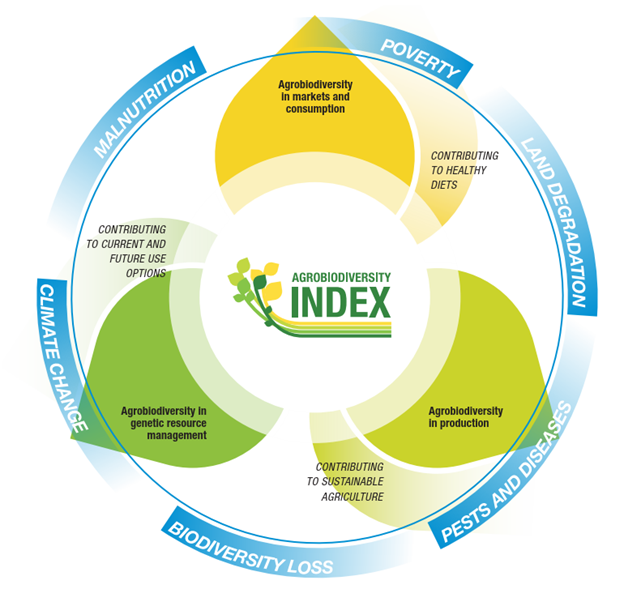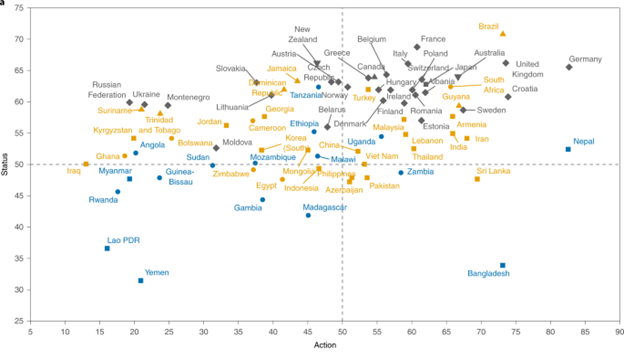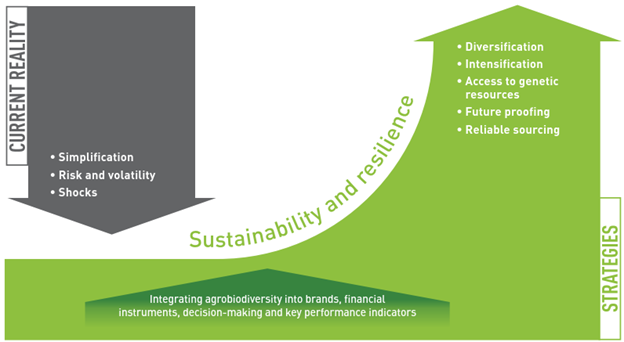
Author: Sarah K. Jones.
Food systems are at the nexus of climate, biodiversity and nutrition crises, three of the major global challenges of our time. Creating more sustainable food systems is vital for us to have any chance of solving these crises. And making better use of agrobiodiversity is one ready-to-go solution that has positive knock-on effects across the climate-biodiversity-nutrition nexus.
Most recently, the Curt Bergfors Foundation acknowledged the significant role of agrobiodiversity in fostering sustainable food systems by awarding the esteemed Food Planet Prize to the Agrobiodiversity Index, co-led by Roseline Remans, Sarah K. Jones, and Natalia Estrada Carmona, from Alliance BI-CIAT.
With a focus on the imperative for enhanced integration of agrobiodiversity into food system planning, Sarah Jones has led the development of an agroecological practice module for the FABLE Calculator. This module allowes users to assess the impact on national and global food, biodiversity, and climate targets when cropland is converted from monocultures and high-chemical input systems to agrobiodiverse and low-chemical input systems, or vice versa. The conversion of existing agricultural land to agrobiodiverse and biodiversity-friendly practices is at the heart of Global Biodiversity Framework Target 10, to which countries worldwide have committed to achieving by 2030. The newly introduced module is specifically designed to assist policymakers in planning strategies to reach this significant target.
In this blog, Sarah sheds light on three compelling reasons why the Agrobiodiversity Index stands as a potential gamechanger for sustainable food systems.
1. Making a positive call to action.
The Agrobiodiversity Index uses a whole food system approach to measure the gap between the plants, animals, and microorganisms that support food and agriculture – called agrobiodiversity - that we HAVE in our food system, and the agrobiodiversity we COULD have, to maintain healthy diets and resilient production systems, now and for our grandchildren.
We are living at a time when we can almost feel the planet’s boundaries around us, the limits of what the planet can take from us. We all know we need to be reducing the consumption of nearly every natural resource. Yet there is one resource that we should be using much more of and that’s agrobiodiversity. Maintaining biodiversity in food and agricultural systems helps keep the whole system healthy, and this is really our message.
The more we use agrobiodiversity, the more we have of it. So we need to eat it, we need to plant it, we need to save it.

Ways that agrobiodiversity contributes to sustainable and resilient food systems. Credit: Alliance of Bioversity International & CIAT / P.Gallo.
2. We need to measure what matters so we can manage what matters.
And the Agrobiodiversity Index was created with this very much in mind. People value biodiversity in food systems for very different reasons depending on where they live and where they are in the food system, from farm to fork. And we know this, because we asked them. This because, when the index was designed we consulted with over 500 individuals all along the food supply chain to ask them what aspects of agrobiodiversity they would want to see measured and why.
Until recently, agrobiodiversity in each part of the food system was monitored in isolation, or ignored completely in both biodiversity conservation and food system circles. Now 198 countries have signed up to the post-2020 Global Biodiversity Framework which includes the Agrobiodiversity Index as an indicator for Target 10 on biodiversity friendly production practices. And 35 companies are already using the Agrobiodiversity Index to help monitor the sustainability of their food supply chains through HowGood.
And we are very excited that it’s our index these countries and companies are using, because we think it does a good job of capturing the different values that people put on biodiversity in food systems, the values that matter to different people for different reasons. This helps actors connect the dots between actions to use and safeguard agrobiodiversity in conservation, production and consumption parts of the food system.

Figure showing the gap between the agrobiodiversity that countries have and the agrobiodiversity they could have (y-axis), together with the gap in actions needed to make best use of agrobiodiversity (x-axis). Source: Figure 3 from Jones et al. 2021.
3. The Agrobiodiversity Index could be a gamechanger. We want to see a paradigm shift that makes agrobiodiversity a central part of food system decision-making.
Our impacts until now are mainly about the number of governments and companies that have changed their views and their monitoring systems to better account for agrobiodiversity. Now we need to build on this momentum and trigger the next stage in the change process, where these governments and companies introduce the policies, practices and investments that incentivize and enable farmers, consumers, conservationists to shift behaviours.

How integrating agrobiodiversity into policies, practices and investments builds sustainable and resilient food systems. Credit: Alliance of Bioversity International & CIAT / P.Gallo